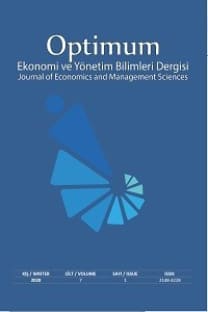Toplumsal Cinsiyet Eşitliği ve BIT’ in Çocuk Gelişimi Üzerine Etkisi: Bir Kesit Veri Analizi
Bu çalışma çocuk gelişimi ile toplumsal cinsiyet eşitliği, bilgi iletişim teknolojileri (BIT), ve kurumsal değişkenler gibi çocuk gelişimi belirleyicilerinin arasındaki ilişkiyi incelemek amacıyla 136 ülke için 2006 yılı kesit veri seti kullanılarak yapılmıştır. Çalışmamızda çocuk gelişiminin toplumsal cinsiyet eşitliği ile ilgili olup olmadığı, çocuk gelişimi ve toplumsal cinsiyetin birden fazla boyutunu ele alabilmek amacıyla, sırası ile Çocuk Gelişimi Endeksi (CDI) ve Toplumsal Cinsiyet Gelişim Endeksi (GDI) kullanılarak test edilmiştir. Çalışma, toplumsal cinsiyet eşitliğinin bütün regresyonlarda en güçlü ve en önemli değişken olduğunu ve etkisinin kurumsal kalite ve BIT gibi kontrol değişkenlerinin regresyona dahil edildiği durumda bile asla kaybolmadığını göstermiştir.
Anahtar Kelimeler:
Toplumsal Cinsiyet Eşitsizliği, Çocuk Gelişimi, BIT, Kurumsal Kalite
The Impact of Gender Equality and ICT on Child Development: A Cross Country Analysis
The study uses a cross-sectional data set collected in 2006 for 136 countries in order to examine the relationship between child development and its determinants, such as the gender equality, information communication technology (ICT), and institutional variables. We test whether the child development is related to gender equality, by using Gender Development Index (GDI) and Child Development Index (CDI) to take into account more than one dimension of gender equality and child development, respectively. The study finds that the impact of gender equality is most robust and significant variable in all regressions and its impact never disappears when control variables, such as the institutional quality and ICT, are incorporated into the regressions.
Keywords:
Gender Inequality, Child Development, ICT, Institutional Quality,
___
- Aslam, M. , & Kingdon G. (2010). Parental Education and Child Health –Understanding the Pathways of Impact in Pakistan, Centre For The Study of African Economies (CSAE), Working Paper Series, No.16
- Atkinson, N.L., Silsby J., Gold R.S., Koeppl P.T., Chokshi A.N., & Gutierrez, L.S. (2001). Technology and Child Development, Part I A Ten-Year Review of Reviews, The Public Health Informatics Research Laboratory
- Burchi, F. (2009). On the Contribution of Mother’s Education to Children’s Nutritional Capabilities in Mozambique, Università degli Studi Roma TRE, Dipartimento di Economia, Working Paper, No. 101
- Chen, Y. , & Li, H. (2006). Mother’s Education and Child Health: Is There a Nurturing Effect? ,Guanghua School of Management, Peking University, Beijing
- Cleland, J. , & Ginneken, J.K. (1988). Maternal Education and Child Survival in Developing Countries: The Search for Pathways of Influence, Social Science Medicine, Vol. 27, No 12, pp.1357-1368
- Desai, S., & Alva, S. (1998). Maternal Education and Child Health: Is there a Strong Causal Relationship, Demography, Voulme.35, Number.1, pp. 71-81
- Garrett, J.L., & Ruel, M.T. (1999). Are Determinants of Rural and Urban Food Security and Nutritional Status different? Some Insights from Mozambique, World Development, 27(11), pp. 1955–1975.
- Kirk, D., & Pillet B. (1998). Fertility Levels, Trends, and Differentials in Sub-Saharan Africa in the 1980s and 1990s, Studies in Family Planning, Vol. 29, No. 1, pp. 1-22
- Kulik, C., & Kulik, J. (1991). Effectiveness of computer-based instruction: An updated analysis, Computers and Human Behavior, 7, 75-94.
- Leslie, J. (1989). Women’s work and child nutrition in the third world., Boulder, CO: Westview Press, (pp. 19-58).
- Miller, J. E., & Rodgers Y. V. (2009). Mother’s Education and Children’s Nutritional Status: New Evidence from Cambodia, Asian Development Review, vol. 26, no. 1, pp. 131−165
- Oster, E. (2006). Does Increased Access Increase Equality? Gender and Child Health Investments in India, NBER Working Paper No. 12743. Issued in December 2006
- Phukan, R.K., Barman, M. P., & Mahanta, J. (2008). Factors Associated with Immunization Coverage of Children in Assam, India: Over the First Year of Life, Regional Medical Research Centre for North East, Indian Council of Medical Research, Published by Oxford University Press., doi:10.1093/tropej/fmn025
- Pierce, P.L. (1994). Technology Integration into Early Childhood Curricula: Where We’ve Been, Where We Are, Where We Should Go, Chapel Hill, NC: Center for Literacy and Disability Studies.
- Robeyns, I. (2003). Sen’s Capability Approach and Gender Inequality: Selecting Relevant Capabilities, Feminist Economics, 9:2, pp. 61-92.
- Saito, M. (2003). Amartya Sen’s Capability Approach to Education: A Critical Exploration, Journal of Philosophy of Education, Vol. 37, No. 1
- Save the Children (2008). Child Development Index, Available at: [Available online at: https://www.savethechildren.org.uk/about-us/what-we-do/the-child-development-index ], Retrived on October,2012.
- Sen, A. K. (1997). ëEditorial: Human Capital and Human Capabilityí, World Development, 25(12), 1959-61.
- Smith, L.C., Ramakrishnan, U., Ndiaye, A., Haddad, L., & Martorell, R. (2002). The Importance of Women’s Status for Child Nutrition in Developing Countries, International Food Policy Research Institute, Research Report 131
- The World Bank (2003). Gender Equality and the Millennium Development Goals. [Available online at: http://www.worldbank.org/gender/gendermdg.pdf], Retrived on October,2012.
- The World Bank (2009). World Development Indicators. [Available online at: http://data.worldbank.org/datacatalog/gender-statistics ], Retrived on October,2012.
- United Nations (UN) Human Development report 2007 [Available online at: http://www.aponline.gov.in/Apportal/HumanDevelopmentReport2007/APHDR_2007_Chapter9.pdf ], Retrived on June,2012.
- Yayın Aralığı: Yılda 2 Sayı
- Başlangıç: 2014
- Yayıncı: -
Sayıdaki Diğer Makaleler
Toplumsal Cinsiyet Eşitliği ve BIT’ in Çocuk Gelişimi Üzerine Etkisi: Bir Kesit Veri Analizi
Mehmet BALCILAR, Nezahat KUCUK
İsmail KÜÇÜKAKSOY, İsmail ÇİFTÇİ
Meryem AKOĞLAN KOZAK, Volkan GENÇ
Kurullar ve Bibliyografik Bilgi
Türkiye Ekonomisinde Yapısal Dönüşümler ve İşgücü Piyasasındaki Gelişmeler
G-20 Ülkelerinde Eğitim Harcamalarının Ekonomik Büyüme Üzerindeki Etkisi
Sibel SELİM, Yunus PURTAŞ, Doğan UYSAL
Bağımsız Denetim Standartlarının Muhasebede Hile Kavramına Yaklaşımı
Türkiye’de Kamu Harcamalarının Denetiminde Bütçenin Rolü:2006- 2013 Dönemi Analizi
